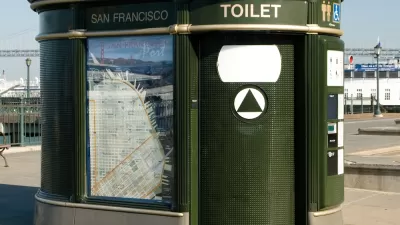In 2006, New York City signed contracts for private-public partnerships that would deliver a variety of street furniture throughout the city. To date, 3,355 bus shelters, 304 newsstands, and three (3) public toilets have been built.
Sam Roberts reports on the slow pace at which a Spanish company called Cemusa, working with the Department of Transportation, has been able to site and install public toilets in New York City.
Here is what has sufficed for progress so far: “The first toilet was installed in Madison Square Park early in 2008, followed by one in Corona, Queens, later that year. The third was placed in Grand Army Plaza, Brooklyn, in 2011.”
“If installation continues at this rate, the 20 automatic toilets for which the city sought bids fully a decade ago will be functioning by about 2065. Of course, even 20 toilets, for a city that swells to nearly 10 million with commuters on a typical weekday, would mean one such facility would serve nearly 500,000 people,” writes Roberts.
As for why it’s been so difficult to install public toilets, despite popular demand: “a number of neighborhoods have responded to the toilets with a not-in-my-backyard indifference, at best,” and “no lavatory lobby has ever materialized.”
Some in New York expected these problems from the outset, and other cities have also found public toilet programs difficult to implement and expensive, at best.
FULL STORY: In 9 Years of Work, Just 3 Public Toilets Go Live

Planetizen Federal Action Tracker
A weekly monitor of how Trump’s orders and actions are impacting planners and planning in America.

Restaurant Patios Were a Pandemic Win — Why Were They so Hard to Keep?
Social distancing requirements and changes in travel patterns prompted cities to pilot new uses for street and sidewalk space. Then it got complicated.

Map: Where Senate Republicans Want to Sell Your Public Lands
For public land advocates, the Senate Republicans’ proposal to sell millions of acres of public land in the West is “the biggest fight of their careers.”

Maui's Vacation Rental Debate Turns Ugly
Verbal attacks, misinformation campaigns and fistfights plague a high-stakes debate to convert thousands of vacation rentals into long-term housing.

San Francisco Suspends Traffic Calming Amidst Record Deaths
Citing “a challenging fiscal landscape,” the city will cease the program on the heels of 42 traffic deaths, including 24 pedestrians.

California Homeless Arrests, Citations Spike After Ruling
An investigation reveals that anti-homeless actions increased up to 500% after Grants Pass v. Johnson — even in cities claiming no policy change.
Urban Design for Planners 1: Software Tools
This six-course series explores essential urban design concepts using open source software and equips planners with the tools they need to participate fully in the urban design process.
Planning for Universal Design
Learn the tools for implementing Universal Design in planning regulations.
Heyer Gruel & Associates PA
JM Goldson LLC
Custer County Colorado
City of Camden Redevelopment Agency
City of Astoria
Transportation Research & Education Center (TREC) at Portland State University
Camden Redevelopment Agency
City of Claremont
Municipality of Princeton (NJ)





























